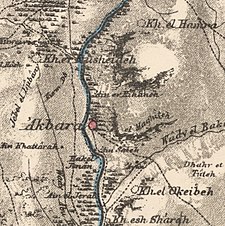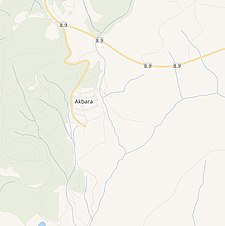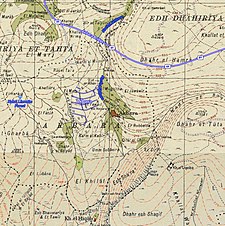'Akbara
'Akbara
عكبرة | ||
|---|---|---|
Village | ||
 Modern village of Akbara | ||
| Etymology: possibly from male jerboa[1] | ||
A series of historical maps of the area around 'Akbara (click the buttons) | ||
Geopolitical entity Mandatory Palestine | | |
| Subdistrict | Safad | |
| Date of depopulation | 10 May 1948[2] | |
| Area | ||
| • Total | 3,224 dunams (3.224 km2 or 1.245 sq mi) | |
| Population | ||
| • Total | 390 | |
| Cause(s) of depopulation | Military assault by Yishuv forces | |
'Akbara (
Location
The village of 'Akbara was situated 2.5 km south of
History
The first 'Akbara mention is during
The nearby Khirbet al-'Uqeiba was first excavated during the Mandate period, and was shown to contain remains such as building foundations, hewn stones, and wine presses.[9] Cisterns,[10] tombs, oil press and walls of ancient synagogue have also been found.[11] Foerster identifies the ruins as the "early Galilean type" synagogue.[12] According to Liebner, a 1965 letter in the IAA composed by antiquites inspector N. Tfilinski notes a Hebrew inscription on a building stone found at the site. The current location of the stone is unknown.[13]
Above the settlement, a 135 m high vertical cliff is located. There are one hundred and twenty-nine natural and man-made caves interconnected by passages in the cliff. According to tradition, those caves were used for shelter by Jews during their war with Romans. During archeological excavations, coins from Dor and Sepphoris were found in the caves, dating to the Roman emperor Trajan period.[14]
Akbara/Akbari/Akbora/Akborin is mentioned several times in
The local Jewish community is attested during Fatimid rule of 969 to 1099 by the Cairo Geniza.[24] Samuel ben Samson visited 'Akbara during his 1210 Palestine pilgrimage, he described the tomb of Rabbi Meir he had found there.[25] In 1258 Jacob of Paris visited Akbara and found there, according to Pirkei Avot, tombs of Rabbi Nehurai.[19]
Ottoman era
'Akbara, was incorporated into the
In 1648 a Turkish traveler Evliya Tshelebi visited Galilee and reflected on history of Akbara cliff caves, which according to tradition were used as a shelter by Jews:
"The children of Israel escaped the plague and hid in these caves. Then Allah sent them a bad spirit which caused them to perish within the caves. Their skeletons, heaped together, can be seen there to this day."[14]
In 1838, it was noted as a village in the Safad district,[29] while in 1875 Victor Guérin visited, and described it thus:
"The ruins of Akbara cover a hillock whose slopes were formerly sustained by walls forming terraces; the threshing floors of an Arab village occupy the summit. Round these are grouped the remains of ancient constructions now overthrown." "The village lies on the east of the wady. It is dominated by a platform on which foundations can be traced of a rectangular enclosure called el Kuneiseh, measuring thirty paces in length by twenty-three in breadth. It stands east and west, and was firmly constructed of good cut stones. The interior is at present given up to cultivation. This enclosure seems to have been once a Christian church."[30]
In 1881, the PEF's Survey of Western Palestine (SWP) described Akbara as a village built of stone and adobe with about 90 inhabitants who cultivated olive and fig trees.[31]
A population list from about 1887 showed Akbara to have about 335 inhabitants, all Muslims.[32]
British Mandate era

In the 1922 census of Palestine conducted by the British Mandate authorities, Akbara had a population of 147; all Muslims,[33] increasing in the 1931 census to 275, still all Muslims, in a total of 49 houses.[34]
During this period the village houses were made of masonry.[35] In the 1945 statistics the population was 390 Muslims,[4] and the total land area was 3,224 dunums;[3] 2,222 dunums was used for cereals, 199 dunums were irrigated or used for orchards,[36] while 6 dunams were built-up (urban) land.[37]

Israeli era
During the siege of Safad 'Akbara was targeted for occupation in line with
On 25 May 1948, during
"The remaining villagers said that they had been ’forced with their hands to destroy their dwellings,’ and had been treated like ’cattle.’ They were then dumped on a bare, sun-scorched hillside near the village of ’Akbara [by then an abandoned Palestinian Arab village] where they were left ’wandering in the wilderness, thirsty and hungry.’ They lived there under inhuman conditions for years afterwards," along with the inhabitants of at least two other villages (Qaddita and al-Ja'una) expelled in similar circumstances.[42]
The expellees remained at ’Akbara for eighteen years until agreeing to resettlement in Wadi Hamam.[41]

Of what remains of 'Akbara's built structures, Walid Khalidi wrote in 1992 that "The original inhabitants of the village were replaced by 'internal' refugees from Qaddita villages several kilometers north of Safad. Since 1980, however, these internal refugees have been gradually relocated to the nearby, planned village of 'Akbara, 0.5 km west of the old village site. As a precondition of the relocation, each family was required to demolish its home in the former village. Today, fifteen of the old houses still stand on the site, in addition to the school. The new village of 'Akbara was placed under the administration of the city of Safad in 1977.[44][45] It is now a neighbourhood of the city of Safed.[clarification needed]
See also
- List of massacres committed during the 1948 Arab-Israeli war
References
- ^ Palmer, 1881, pp. 61, 66
- ^ a b Morris, 2004, p. 224
- ^ a b c Government of Palestine, Department of Statistics. Village Statistics, April, 1945. Quoted in Hadawi, 1970, p. 69
- ^ a b Department of Statistics, 1945, p. 9
- ^ Ashkenazi, Eli (2010-11-04). "Safed, a Model for Coexistence or Sectarian Tinderbox?".
- ^ Khalidi, 1992, p. 430.
- ^ Leibner, 2009, p. 108
- ^ Bohstrom, Philippe (2016-09-29). "Caves in Which Jewish Rebels Hid From Romans 2,000 Years Ago Found in Galilee".
- ^ Khalidi, 1992, p. 431
- ^ Dauphin, 1998, pp. 658-9
- ^ Tsafrir, Di Segni and Green, 1994, p. 56
- ISBN 978-0-89130-524-8.
- ISBN 978-3-11-071577-4, retrieved 2024-02-07
- ^ a b
Shivtiel, Yinon; Frumkin, Amos (2014). "The use of caves as security measures in the Early Roman Period in the Galilee: Cliff Settlements and Shelter Caves". Caderno de Geografia. 24 (41): 79–81, 85–87. ISSN 2318-2962.
- ISBN 978-3-16-148514-5.
- ISBN 978-3-16-148567-1.
- ISBN 978-90-04-17838-0.
- ^ Leibner, 2009, p. 109
- ^ a b c Conder and Kitchener, 1881, SWP I, p. 205
- ^ Albert Victor (duke of Clarence and Avondale); George V (King of Great Britain) (1886). The Cruise of Her Majesty's Ship "Bacchante", 1879-1882: The East. Macmillan and co. p. 695.
- ^ Dov Aryeh B. Leib Friedman (1896). Rabbis of Ancient Times: Biographical Sketches of the Talmudic Period (300 B.C.E. to 500 C.E.). Supplemented with Maxims and Proverbs of the Talmud. Rochester Volksblatt. pp. 19–20.
- ^ Benjamin De Tudèle (1841). The Itinerary of Rabbi Benjamin of Tudela. A. Asher. p. 427.
- ^ Heinrich Graetz (1873). History of the Jews from the Downfall of the Jewish State to the Conclusion of the Talmud. American Jewish Publication Society. pp. 167–168.
- ^ Leibner, 2009, p. 106
- ISBN 978-1-134-28606-5.
- ^ Leibner, 2009, p. 107
- ^ Hütteroth and Abdulfattah, 1977, p. 176. Note that there is a typo in the grid numbers; they give grid numbers 197/200 for Akbar al-Hattab, however, on their maps it is placed in the correct position, around 197/260. Rhode, 1979, p. 69 Archived 2019-04-20 at the Wayback Machine correctly places Akbarat al-Hiqab at 197/260
- ^ Rhode, 1979, p. 6 Archived 2019-04-20 at the Wayback Machine writes that the register that Hütteroth and Abdulfattah studied was not from 1595/6, but from 1548/9
- ^ Robinson and Smith, 1841, vol 3, 2nd appendix, p. 134
- ^ Guérin, 1880, pp. 351–353, as given by Conder and Kitchener, 1881, SWP I, p. 219
- ^ Conder and Kitchener, 1881, SWP I, p. 196. Quoted in Khalidi, 1992, p. 430.
- ^ Schumacher, 1888, p. 188
- ^ Barron, 1923, Table XI, Sub-district of Safad, p. 41
- ^ Mills, 1932, p. 105
- ^ Khalidi, 1992, pp. 430–431
- ^ Government of Palestine, Department of Statistics. Village Statistics, April, 1945. Quoted in Hadawi, 1970, p. 118
- ^ Government of Palestine, Department of Statistics. Village Statistics, April, 1945. Quoted in Hadawi, 1970, p. 168
- ^ Morris, 2004, p. 223
- ^ Morris 2004, p. 248
- ^ Morris 2004, p. 250
- ^ a b Benvenisti, 2002, pp. 206-207
- ^ Morris, 2004, pp. 511–512
- ^ Bibliography and References, Palestine Remembered, 25 June 2007, archived from the original on 9 January 2009, retrieved 20 December 2007
- ^ a b Welcome to 'Akbara, Palestine Remembered, archived from the original on 2008-07-04, retrieved 2007-12-20
- ^ Khalidi, 1992, p xix
Bibliography
- Barron, J.B., ed. (1923). Palestine: Report and General Abstracts of the Census of 1922. Government of Palestine.
- ISBN 978-0-520-23422-2.
- Conder, C.R.; Kitchener, H.H. (1881). The Survey of Western Palestine: Memoirs of the Topography, Orography, Hydrography, and Archaeology. Vol. 1. London: Committee of the Palestine Exploration Fund. (p. 205)
- ISBN 0860549054.
- Department of Statistics (1945). Village Statistics, April, 1945. Government of Palestine.
- ISBN 1-84519-075-0.
- Guérin, V. (1880). Description Géographique Historique et Archéologique de la Palestine (in French). Vol. 3: Galilee, pt. 1. Paris: L'Imprimerie Nationale.
- Hadawi, S. (1970). Village Statistics of 1945: A Classification of Land and Area ownership in Palestine. Palestine Liberation Organization Research Center.
- Hütteroth, Wolf-Dieter; Abdulfattah, Kamal (1977). Historical Geography of Palestine, Transjordan and Southern Syria in the Late 16th Century. Erlanger Geographische Arbeiten, Sonderband 5. Erlangen, Germany: Vorstand der Fränkischen Geographischen Gesellschaft. ISBN 3-920405-41-2.
- ISBN 0-88728-224-5.
- Leibner, Uzi (2009). Settlement and History in Hellenistic, Roman, and Byzantine Galilee: An Archaeological Survey of the Eastern Galilee. Mohr Siebeck. ISBN 978-3-16-149871-8.
- Mills, E., ed. (1932). Census of Palestine 1931. Population of Villages, Towns and Administrative Areas. Jerusalem: Government of Palestine.
- Moore, Dahlia; Aweiss, Salem (2004). Bridges Over Troubled Water: A Comparative Study Of Jews, Arabs, and Palestinians. Praeger/Greenwood. ISBN 0-275-98060-X.
- ISBN 978-0-521-00967-6.
- Nazzal, Nafez (1978). The Palestinian Exodus from Galilee 1948. Beirut: The Institute for Palestine Studies. pp. 43–45. ISBN 9780887281280.
- Palmer, E.H. (1881). The Survey of Western Palestine: Arabic and English Name Lists Collected During the Survey by Lieutenants Conder and Kitchener, R. E. Transliterated and Explained by E.H. Palmer. Committee of the Palestine Exploration Fund.
- Rhode, H. (1979). Administration and Population of the Sancak of Safed in the Sixteenth Century (PhD). Columbia University. Archived from the original on 2020-03-01. Retrieved 2017-11-03.
- Robinson, E.; Smith, E. (1841). Biblical Researches in Palestine, Mount Sinai and Arabia Petraea: A Journal of Travels in the year 1838. Vol. 3. Boston: Crocker & Brewster.
- ISBN 978-0-521-87598-1.
- Schumacher, G. (1888). "Population list of the Liwa of Akka". Quarterly Statement - Palestine Exploration Fund. 20: 169–191.
- ISBN 965-208-107-8.
External links
- Welcome to Akbara
- 'Akbara, Zochrot
- Survey of Western Palestine, Map 4: IAA, Wikimedia commons
- 'Akbara, at Khalil Sakakini Cultural Center
- Akbara, Dr. Khalil Rizk.
- 3akbara from Dr. Moslih Kanaaneh




